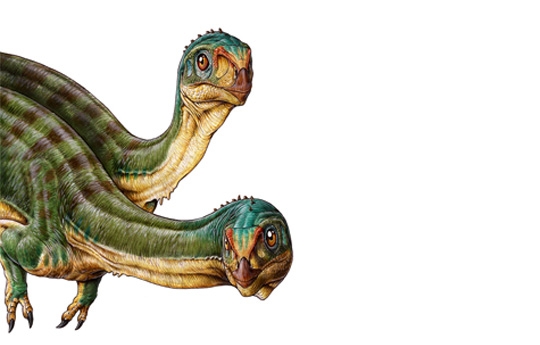EXACT AND NATURAL SCIENCES
Chilesaurio diegosuarezi, an evolutionary puzzle
In 2004, a seven year old boy found the first remains of this incredible herbivorous dinosaur which has characteristics of different species.
A bizarre dinosaur of the Late Jurassic period – about 148 millions of years- was presented in Chile. The remains were found in 2004 in an archaeological site which seemed to contain several species, but finally palaeontologists discovered the find belonged to one specimen described as an “evolutionary mosaic”.
The Chilesaurio diegosuarezi was presented by a team of palaeontologists lead by Fernando Novas, CONICET principal researcher at the Bernardino Rivadavia Natural Sciences Museum (MANC-CONICET) and Manuel Suárez, director of Geology at the Faculty of Engineering, Andrés Bello University, Chile. Diego is Suarez’s son, who discovered the remains when he was only seven; hence this new dinosaur was named after him.
“The combination of a small head, leaf-shape teeth – to cut leaves -, and robust legs are all unusual for theropods”, Novas explains.
Chilesaurio diegosuarezi was described as a combination of three main lineages in which dinosaurs are divided: theropods, such as the Tyrannosaurus Rex; sauropodomorph, like the brontosaurus; and the ornithischia, as the Triceratops. “Nobody had ever expected to discover it in any part of the World”, the researcher affirms.
The parts of this new specimen were found by Diego Suárez near the Lago General Carrera in Mallin Grande, Chile, during the fieldwork conducted by the kid’s parents, Manuel Suárez and Rita de Cruz, two Chilean geologists. “Since he was five, he has joined us in different fieldworks, ‘helped’ us to find rock samples and participated in the discovery of shells and leaves fossils”, Manuel Suárez states.
Novas comments that the first bones were taken to the Museum of La Plata because they seemed to be marine reptiles. For his part, Leonardo Salgado, CONICET independent researcher at the Instituto de Investigaciones en Paleobiología y Geología de la Universidad Nacional de Río Cuarto [Paleobiology and Geology Research Institute of the University of Rio Cuarto, Córdoba], individually described them in a study published in 2007. As there were doubts regarding some parts, he contacted Novas and hence the second stage of the discovery began.
The remains were analysed at the Palaeontology area of the MACN, which is led by Marcelo Isasi, CONICET professional technician. There, the researchers found that the backbone, the ribs and both arms that seemed to belong to different specimens were actually part of one dinosaur whose size was similar to the one of a hen. Thus, researchers decided to return and find more parts.
“The remains seemed to be part of different dinosaurs, but as the skeleton was complete we found that they belonged to only one: the Chilesaurius. It is as if it represented a mosaic of dinosaurs in one animal”, Novas concludes.
- By María Bocconi.
- Versioning: Cintia B. González.
- About the research:
- Fernando E. Novas. CONICET principal researcher, MACN-CONICET.
- Leonardo Salgado. CONICET principal researcher. National University of Río Cuarto.
- Manuel Suárez. Andrés Bello University, Santiago de Chile, Chile.
- Federico L. Agnolín. Doctoral fellow, MACN-CONICET. Fundación de Historia Natural Félix de Azara. Maimónides University.
- Martín D. Ezcurra. School of Geography, Earth and Environmental Sciences, University of Birmingham, Birmingham, United Kingdom.
- Nicolás R. Chimento. Doctoral fellow, MACN-CONICET.
- Rita de la Cruz. National Geology and Mining Service of Chile.
- Marcelo P. Isasi. Associate professional, MACN-CONICET.
- Alexander Vargas. Faculty of Sciences. University of Chile. Chile.
- David Rubilar-Rogers. Department of Biology, Faculty of Sciences. University of Chile. National Museum of Natural History of Chile, Chile.
